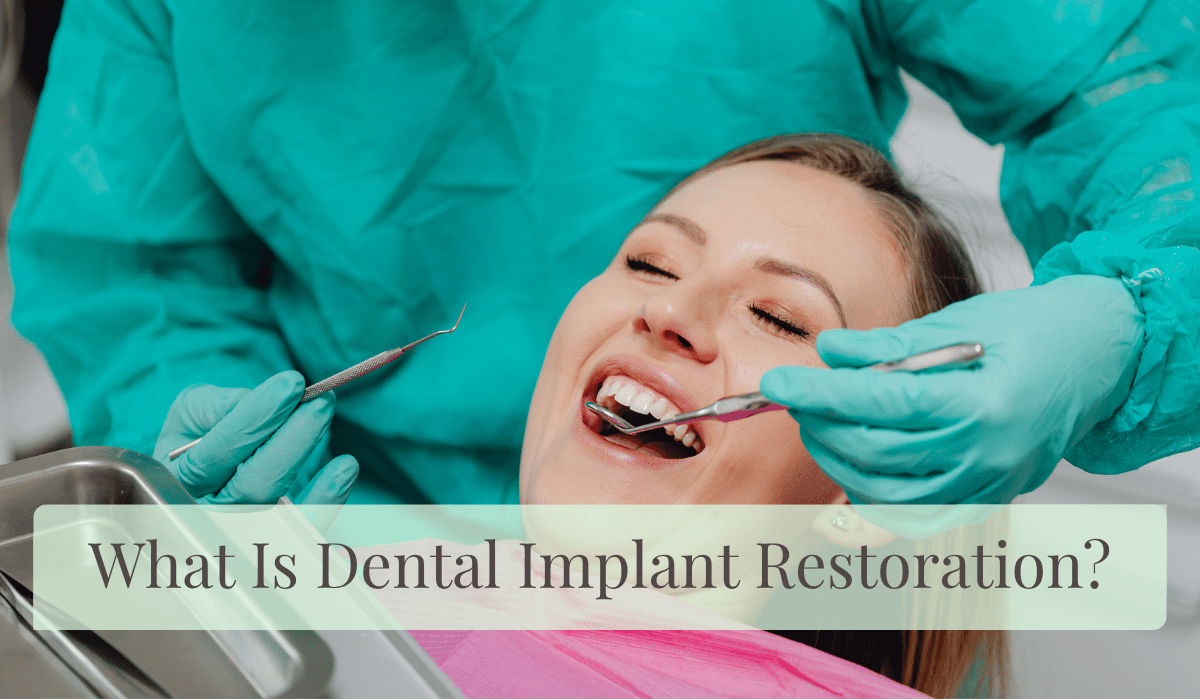Dental implant restoration is an option for some patients with one or more missing teeth in which a titanium post is implanted into the jawbone to support an artificial tooth or teeth.
Dental implants include an abutment and crown and are designed to look like a person’s real teeth. While getting implants can provide a person with the cosmetic benefit of having a more complete smile, it can also yield various oral health benefits related to speaking, eating, and beyond.
Dental implant restorations are designed to appear indistinguishable next to a patient’s existing teeth. These implants are permanently anchored into the bone with the dental crown visible and fully functional.
There are two main procedures for facilitating dental implants:
- Cemented. In this method, the implant is cemented in place to later support an artificial tooth. It provides stability for a dental crown and should not be visible.
- Screw-retained. An implant screw is permanently implanted into the jawbone to anchor an artificial tooth. This step is more often preferred by dentists and patients alike because repairing the implant is considerably easier than doing so with a cemented implant.
Eligibility for Dental Implant Restoration Procedure
One of the main reasons patients inquire about implant restoration is because they are missing one or more teeth. On a cosmetic level, people who are missing teeth may have lower self-confidence and feel as though they cannot smile or speak for fear of others noticing.
In cases where a person’s tooth breaks or is knocked out by a blow to the mouth, an emergency implant restoration may be needed.
For a dental implant restoration to take place, the patient must have enough healthy bone in part of the jaw where the tooth is missing for an implant post to be inserted. Without that, the process may not be possible.
What to Expect with Dental Implant Restoration
Patients whose dentist recommends dental implant restoration can expect the process to take anywhere from two to three appointments. The time discrepancy can be for a variety of reasons ranging from pre-procedure tooth extractions to the number of implants a patient requires.
Since implants are anchored in the bone, it is critical that a patient have enough available jawbone to support the implant. Once this is verified by the dental professional, work can begin.
There are three main components for the dental implant restoration:
- Implant
- Abutment
- Crown
The dentist may put a titanium implant in the space where a tooth is now missing. This can require the dentist to make a relatively small cut in the gum to gain access to the jawbone where the implant will be anchored. Once the implant is in place, the adjacent gum is stitched back together over it. It can take up to three to six months or more for the implant to anchor itself properly and permanently in the bone through a process called osseointegration, in which the jawbone will fuse with the post. This is a slow but necessary step to ensure the viability of the implant. An x-ray may be taken to ensure osseointegration has been successful before moving on to the next step.
With the implant secured in the jawbone, the next step is to attach an implant abutment and crown. The abutment is essentially a connector post that is threaded and will be attached to the implant post. This provides the base for the implant crown to be attached, which gives the appearance and function of a natural tooth.
Crowns are designed to last when properly cared for, but there could be instances in which one could crack or need to be replaced. A broken dental implant or broken crown should be able to be replaced but requires a reputable dentist familiar with the procedure.
During each step of the process, it is vitally important that the patient care for each component with good oral hygiene and a relatively soft diet. Once the implants are strong enough to begin eating, the dentist will advise as such.
Once the process is fully completed, patients should still dedicate themselves to properly caring for their implants by:
- Staying on top of good oral hygiene practices
- Avoiding hard foods that are overly hard, crunchy, or sticky
- Keeping regular appointments for checkups and cleanings with the dentist
Key Benefits of Dental Implant Restorations
Perhaps the most obvious benefit of dental implant restorations is the cosmetic advantage as the patient will no longer appear to be missing one or more teeth. This can be instrumental in boosting one’s self-confidence for daily activities such as smiling, speaking, and eating.
However, the benefits of dental implant restoration go well beyond cosmetic reasons. The additional benefits include:
- Permanent process
- Improved speech
- Enhanced ability to chew food
- Supported facial features (that were unsupported when missing teeth)
- Decreased odds of teeth shifting out of place
If you are missing one or more teeth or suspect you will need a tooth pulled and are looking for options, contact a reputable dentist in Kingwood and make an appointment to see if a dental implant restoration can benefit you and your smile.
- How Can Cosmetic Dentistry Improve More Than Just Your Appearance? - December 5, 2025
- How to Choose the Best Shade for Veneers - October 8, 2025
- How Your Dentist Plans a Smile Makeover: Step-by-Step Guide to Your New Smile - September 2, 2025




